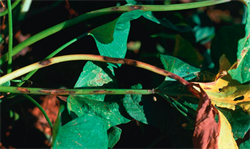- Moderately widespread. Important fungus disease of sweetpotato of Eastern and Central Africa. Recorded from PNG. Yield losses worst in cool, moist highlands, above 1500masl. At least four species described.
- Small, dark brown/black oval spots, on mature leaves, up to 5mm diameter, merging, with yellow halos and ring patterns. Veins on underside of leaves turn black. Later, leaves yellow and fall. Grey spots on stems and petioles becoming black and sunken.
- Spread: spores on the wind and in wind-driven rain. Over long distances on cuttings used for planting. Survival in soil, on plant debris.
- Biosecurity: risk from unofficial introduction of vines and storage roots. Official movement of germplasm should always follow the FAO/IPBGR Technical Guidelines.
- Biocontrol: none.
- Cultural control: select vines free from old leaves and spots; raise disease-free vines from storage roots in nurseries; weed; at harvest, collect and burn/bury old vines or compost. NASPOT varieties bred for Africa for resistance to Alternaria blight, and sweet potato virus disease. Selections and breeders’ lines available in South Africa. Chemical control: Mancozeb, copper compounds, or the mixture azoxystrobin-difenoconazole.





